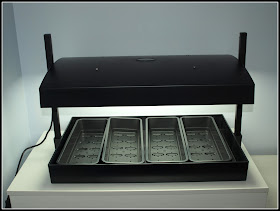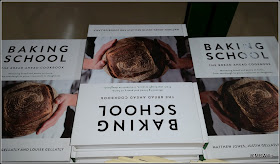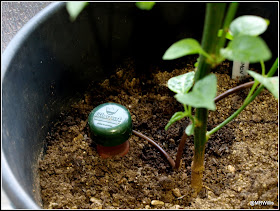Many readers will know by now that I am very interested in fungi. I'm not, and never expect to be, a great expert on this subject. For me it is just a hobby, but a fascinating one.
 |
| A tree-stump with at least 5 different types of fungus |
Until I started taking a serious interest in fungi, I thought of them as things you only found in the Summer and Autumn, and I didn't believe that they would be in evidence during the Winter. I now know that that is not true. There are fungi to be seen all year round - just different ones at different times. Having been studying fungi for about two years now, I'm beginning to know what is in season. As one of the members of the "Mushroom Spotters UK" Facebook Group, to which I belong, recently said "Winter is the season of brackets, crusts and blobs!". I'll demonstrate...
A b
racket fungus is one that grows out horizontally from its host, like a shelf. It normally doesn't have any significant stem (aka "stipe"). This is an example:
 |
| Ganoderma sp. |
Where I live, in NE Hampshire, Birch trees abound, and one of the most commonly-seen bracket fungi is the Birch Polypore - Fomitopsis betulina - also known as the Razor-strop fungus because apparently they were used in the old days for sharpening razor blades!
 |
| Fomitopsis betulina |
The Birch Mazegill - Lenzites betulinus - is also very common.
 |
| Lenzites betulina |
Their colours vary a lot. This one is the same species.
 |
| Lenzites betulinus |
The undersides have a very distinctive maze-like pattern of spore-bearing slots. Hence the name "Mazegill".
 |
| Lenzites betulinus |
The Blushing Bracket - Daedaleopsis confragosa - is a lover of Willow and Poplar trees which often grow in wet, boggy soil - again quite common around here! This fungus gets its name from the fact that it starts off life being a sort of off-white colour and as it ages it gradually goes a deep red, as seen in the next two photos.
 |
| Young Daedaleopsis confragosa |
 |
| Mature Daedaleopsis confragosa |
OK, now for some
crust fungi. As the name suggests, this type normally grows along the surface of its host rather than jutting out from it like the brackets. Having said that, crust fungi do often curl up at the edges to make sort of cup-shapes. I have been unable to find a positive ID for this one, but it is a classic example of the "Curtain Crust" type:
Perhaps the most common crust fungus in my area is the Hairy Curtain Crust - Stereum hirsutum - aptly named because it has hairs on its upper surfaces. You can just about see some here:
 |
| Stereum hirsutum |
Often seen on rotting fallen branches of deciduous trees is the fungus called Stereum rameale (it doesn't appear to have a common name). Superficially similar to the Stereum hirsutum, this one lacks the hairs.
 |
| Stereum rameale |
Other types of crust fungi lie very close to their host substrate, often lurking on the underside of a fallen branch, where they are not immediately visible. This one is Basidioradulum radula - the Toothed Crust. It has a multitude of little spines.
 |
| Basidioradulum radula |
Of course, fungi come in all shapes and sizes, so let me just show you this lovely purple-coloured specimen. I'm not sure of its identity, but it may possibly be (or be related to) Chondrostereum purpureum - Silverleaf Fungus.
Finally, let's see some
blobs. (No, that's not an official term). Many of these are different types of jelly fungus.
By far the most common round here is Tremella mesenterica - Yellow Brain Fungus.
 |
| Tremella mesenterica |
The Purple Jellydisc, though diminutive in size, is also very prolific.
 |
| Ascocoryne sarcoides |
There is another closely related one called Ascocoryne cylichnium:
 |
| Ascocoryne cylichnium |
During January, I saw lots of the black Exidia types, like this Exidia plana.
 |
| Exidia plana |
You can't get much more blob-like than this, which I think is Exidia nucleata aka Myxarium nucleatum - Crystal Brain Fungus.
I could go for ages like this, but I'm going to end my post today with photos of three edible fungi very much in the news on all the fungi-foraging websites during Winter. The first is Flammulina velutipes - Velvet Shank.
 |
| Flammulina velutipes - showing upper surface |
This very good-looking mushroom is named after the velvety texture of its stems:
 |
| Flammulina velutipes - showing the velvety stem |
Now we have Pleurotus ostreatus - the Oyster Mushroom, named after its alleged resemblance to the similarly-named bivalve marine mollusc.
 |
| Pleurotus ostreatus |
Finally, one which I was really pleased to find for the first time just a few days ago, the Scarlet Elf Cup - Sarcoscypha austriaca. Opinions vary concerning its edibility. Everyone seems to agree that it's not poisonous, but few people think it tastes nice. We have to agree that it looks stunning though. Imagine these in a salad...
 |
| Sarcoscypha austriaca |
I hope you have enjoyed my little fungus-foray today. Hopefully I have convinced you that there are plenty of fungi to see even in the depths of Winter. I intend to post more about my finds in the not too distant future.



























































